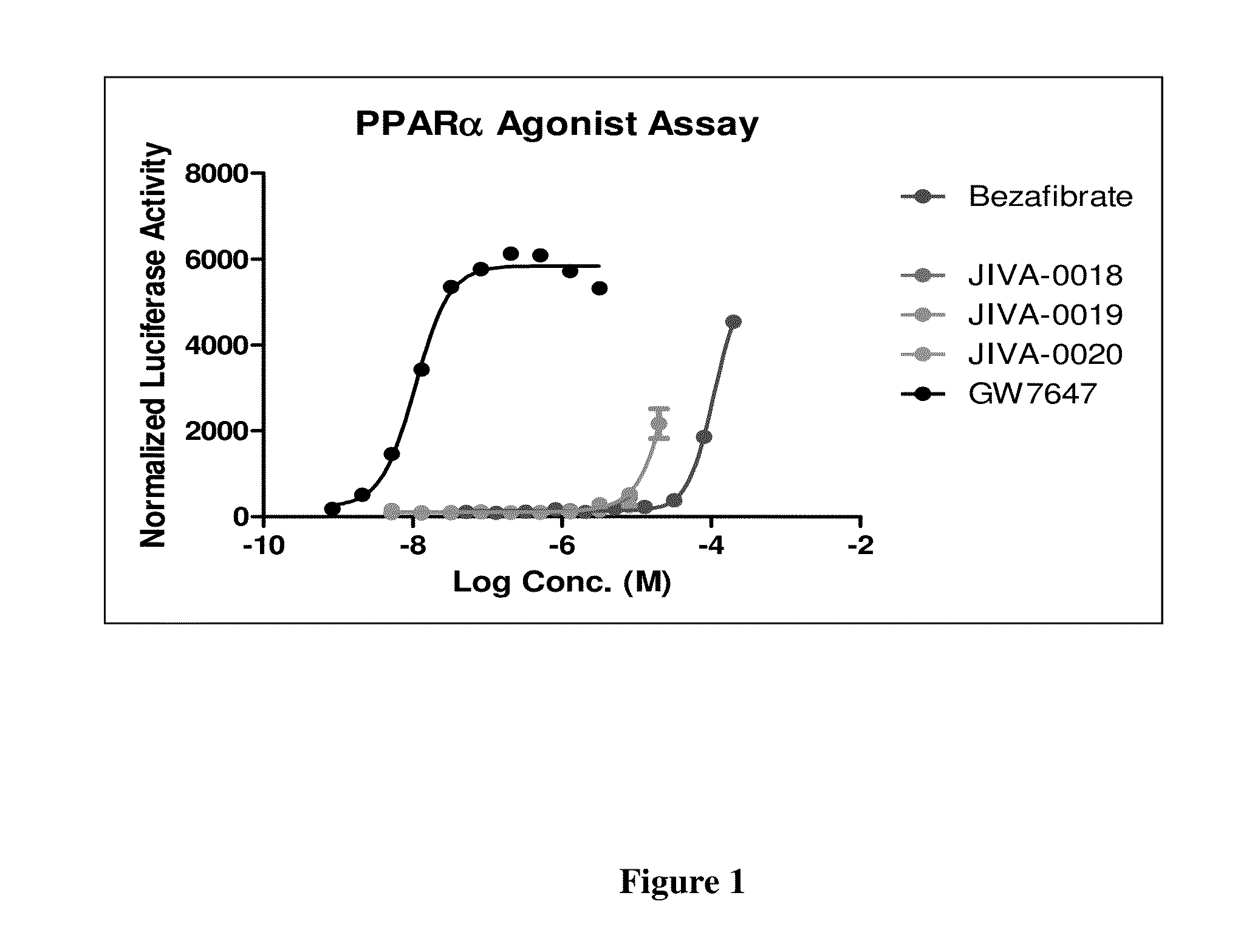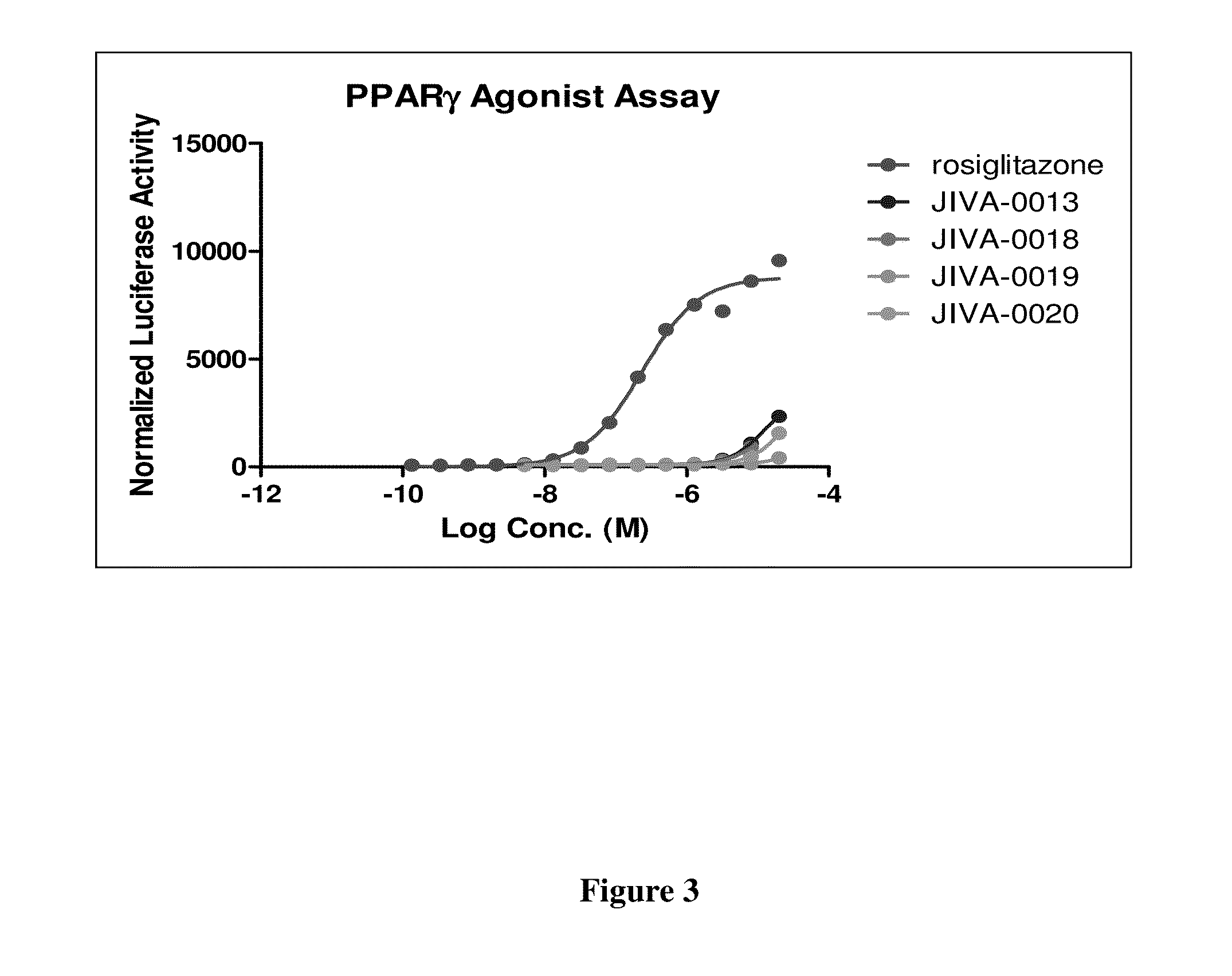Omefibrates for Treating Dyslipidemia and Cardiovascular Disease
a technology of omefibrates and dyslipidemia, applied in the field of omefibrates for treating dyslipidemia and cardiovascular disease, can solve the problems of coronary heart disease, chd) continues, impaired quality of life and mortality around the world, etc., and achieves the effects of high serum triglycerides, elevated blood pressure, and elevated fasting plasma glucos
- Summary
- Abstract
- Description
- Claims
- Application Information
AI Technical Summary
Benefits of technology
Problems solved by technology
Method used
Image
Examples
example 1
EPA Alcohol, 1
[0065]
[0066]An oven-dried 100 mL round bottomed flask was charged with lithium aluminum hydride (0.76 g, 20 mmol) in anhydrous THF (15 mL). The flask was then cooled to 0° C. with an ice-water bath. To this suspension was added drop-wise a solution of EPA ethyl ester (3.30 g, 10 mmol) in THF (10 mL) via syringe under argon. When the addition was complete, the mixture was stirred for 3 hr at 0° C. The reaction was monitored by TLC. After the reaction was complete, it was quenched at 0° C. by slow drop-wise addition of saturated aqueous solution of sodium sulfate (4 mL). The mixture was stirred for 0.5 hr at RT and then filtered through a Büchner funnel. The residue was rinsed with THF. The filtrate and washings were combined and concentrated under reduced pressure to obtain 2.88 g of EPA alcohol as a yellow oil, yield: 100%, and is characterized by the following spectra:
[0067]1H NMR (300 MHz, CDCl3 / TMS): δ 5.50-5.20 (m, 10H), 3.65 (t, J=6.5 Hz, 2H), 2.92-2.75 (m, 8H), 2...
example 2
EPA Bromide, 2
[0069]
[0070]To a solution of EPA alcohol (2.88 g, 10 mmol, prepared as in Example 1) and carbon tetrabromide (3.65 g, 11 mmol) in anhydrous methylene chloride (20 mL) was added triphenylphosphine (2.89 g, 11 mmol) in 4 portions with an interval of 15 min. in between each portion at 0° C. The resulting reaction mixture was stirred at 0° C. The reaction was monitored by TLC. After 4 hr the reaction mixture was concentrated under reduced pressure. Hexanes (30 mL) were added and the mixture was cooled and filtered to remove triphenylphosphine oxide. The filtrate and washings were concentrated under reduced pressure to give crude product as a yellow oil. Purified by silica gel column chromatography (1% ethyl acetate / heptane) provided EPA bromide 2 as colorless oil (3.27 g), yield: 93% and is characterized by the following spectra:
[0071]1H NMR (300 MHz, CDCl3 / TMS): δ 5.45-5.22 (m, 10H), 3.41 (t, J=6.8 Hz, 2H), 2.90-2.70 (m, 8H), 2.15-2.00 (m, 4H), 1.95-1.81 (m, 2H), 1.58-1.4...
example 3
EPA Fibrate Ethyl Ester, 3 (JIVA-0015)
[0073]
[0074]Lithium diisopropylamide solution in THF / Heptane / ethylbenzene (11.0 mL, 2M, 22 mmol) was added drop-wise to a solution of ethyl isobutyrate (2.55 g, 21.9 mmol) in dry THF (15 mL) at −78° C. The resulting light yellow solution was stirred at −78° C. for 1 hr, a solution of EPA bromide (2.57 g, 7.31 mmol, prepared as in Example 2) in anhydrous THF (5 mL) was added drop-wise. Then the reaction mixture was stirred and warmed to RT overnight under argon. The reaction mixture was quenched with ice (10 g), and 1N HCl (5 mL), and diluted with ethyl acetate (30 mL). The phases were separated and the aqueous phase was extracted with ethyl acetate (10 mL×2). The organic layers were combined, washed with water (10 mL), brine (10 mL), dried over MgSO4, and concentrated under reduced pressure. Purification by silica gel column chromatography (2% EtOAc / heptane) provided the desired EPA fibrate ethyl ester 3 as colorless oil (1.92 g, 68% yield) and ...
PUM
| Property | Measurement | Unit |
|---|---|---|
| temperature | aaaaa | aaaaa |
| chemical purity | aaaaa | aaaaa |
| density | aaaaa | aaaaa |
Abstract
Description
Claims
Application Information
 Login to View More
Login to View More - R&D
- Intellectual Property
- Life Sciences
- Materials
- Tech Scout
- Unparalleled Data Quality
- Higher Quality Content
- 60% Fewer Hallucinations
Browse by: Latest US Patents, China's latest patents, Technical Efficacy Thesaurus, Application Domain, Technology Topic, Popular Technical Reports.
© 2025 PatSnap. All rights reserved.Legal|Privacy policy|Modern Slavery Act Transparency Statement|Sitemap|About US| Contact US: help@patsnap.com



